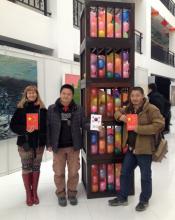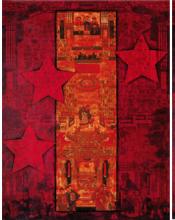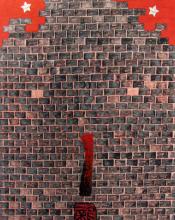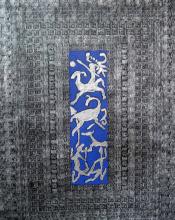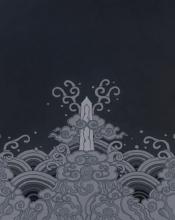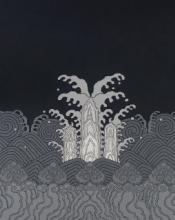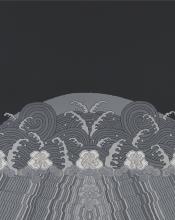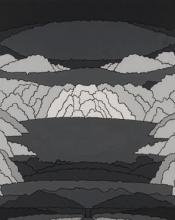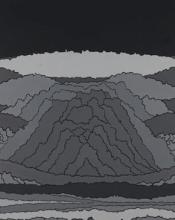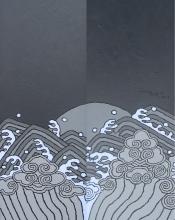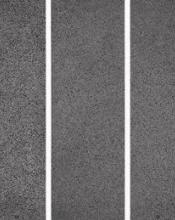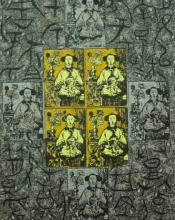Zheng Xuewu
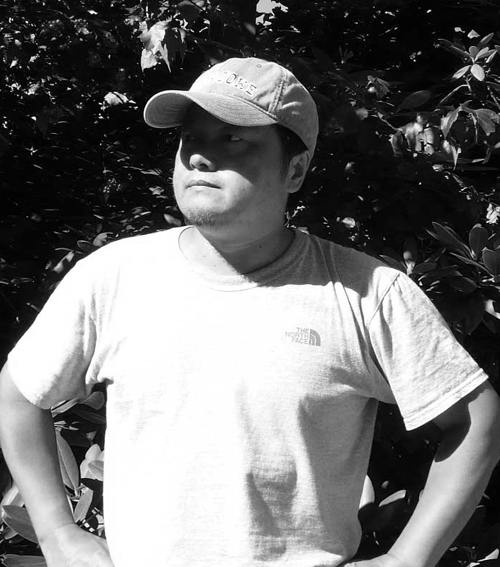
From not being to being, or from being to not being: He Ping
Doctor of Arts of Nanjing Normal University, culture criticism scholar
Honest speaking, if it stays before 1990s, Zheng Xuewu, as an artist can basically be crossed out. Although at that time, Zheng Xuewu already shows out at exhibitions big or small, this kind of showing out has no clear boundary and difference. Zheng’s growing mature in 1990s has no connection with his former creations. I even think some artists’ enter-level and future creations have no connection. He becomes himself after wasting him for a long time. Zheng is almost is kind of artist.
Since 1990s, Zheng Xuewu tries to use the abandoned lead words to his creation. Chinese words become ever-growing art language in his art practice since then. Both Chinese capital and other elements combination game in his No Title serial (1995), in China Image (2004), inscriptions on ancient bronze objects and single storks are shown exaggeratively on frame front view, or even closer Zen’s Words (2007) of “words without any meaning fill the whole picture like pose” (Zheng Xuewy: about Zen’s Words), vision elements of his creation are continuously realized. It does not appear at the right as tool of spreading knowledge, but is continuously separated. In our experiences, meaning of existence of “Words” should come from combination of words as well as word and thing. There is customized language situation for world recognition. Words that are closer to today have even more complicated meaning attached to it, so that it should use various dictionaries to know the details. In thus meaningful “excessive attention”, word as original of word retreats. We just ignore that even single “word” has kind of self-beauty. This is obvious to Chinese character with pronunciation, style and meaning in one. He allows words to get away from its meaning. He ignores relation between word and thing, has no expectation of array and combination of words to refer to our world. Word is just word in paper. He only gives word temporal location on paper. For example, No Title 95-50, tens of words like “Wen”, “Shi”, “Mu”, and “Wen” just leaves their language situation and meet by accident. The amazing thing is there words may lose their meaning to not being, but gain being of art beauty. Array with no order of words naturally soften their self-meaning. Original word for expressing. turns to be beautiful signs. Word becomes flowing line and rhythm is just responsible for beauty.
From the point of Art onto-genetics, art activity of Zheng Xuewu is like children’s game and doodle. This kind of art activity can track back to human’s childhood. At that time, art is intuitive and has no selection of materials. Art materials of Zheng Xuewu includes rubber English capitals, numbers, foam plates, hard plastic material, glass plate, metal materials, Stone carving, rubber sculpture, plastic erosion, cloth and paper, all color materials that can draw water and can leave track easily on paper. Traditional print making uses one piece or pieces of plate to print works. But because Zheng Xuewu uses different materials, his works is formed by different “plates”. Every lead word or every material’s print part is a “plate”. What’s more, Zheng takes no notice of print’s tradition, using hand drawing to fill space of print. Introduction of hand drawing frees his creation from tradition, becoming wandering ghost that cannot be classified. But all because this, Zheng Xuewu’s “print-like” picture combines beauty of print picture as well as freedom of hand drawing.
If we take a closer look, it may not be difficult to find that, the materials that Zheng Xuewu uses are all daily-used articles. He seems to tell us, ignorance to our daily world is just ignorance to art. By his regularization, “materials” are regarded as daily articles without any art features now change to be artistic things. One becomes his grave-digger? Thus we have the reason to ask how Zheng Xuewu will answer the basic question of what is art. Another important question is, maybe he truly gains happiness from “addition”, or even beyond that. Those materials with signs find their places in his art world. But in the en, art is both personal and single, but also public and plural. A true artist can and must find his way to public. From human history angle, more complicated art works can also be explained. I notice in his works in his early period, almost all criticisms or even he realizes there is unique meaning. But except technique uniqueness, seldom can further explain art. I guess this may be auto difficult status. Around 1999, Zheng Xuewu begins “addition” by selection. This period, Zheng’s materials are not just abstract print pleasure----“Color’s Regularization” (works of the same title in 2000), but begins kind of meaningful question. I didn’t try to find form which time, or which work does Zheng find “Artistic China”. But what is sure is the existence of artistic “Old China”. His creations are not just simply from not being to being, but give our world “Art”. Furthermore, it goes a complicated art reflection process from old “being” to new “being”.
One Wall of China (2001), Ink works (2001),The Art of War (2002), Confucianism (2003), Youth to Chairmen Mao (2002), Track of Warring States Period (2003), Chinese Calligraphy (2003), Sunset(2003), Sprit of Mountain and Water (2003), Han Wind (2003), Left Rhyme Serial (2003), China Image Serial (2004), Century Text “China Millennium Monument” (2005), East Mirror (2006-2007),Zen’s Words(2007), Century Text “Shandong Qufu” (2008) and Tiger in Cage (2008), all these are Zheng Xue wu’s personal art history. Just from these titles like wall, ink, mountain and water, Chinese character, Lady's Maid, Jian Book, inscription and Confucian Garden Temple and Palace, Cloth Tiger, he already becomes a creator of “Artistic China”. From careful study to these works related to “China”, it can be roughly seen, around 2003, his composition of his drawing has already undergone art shift from maximalism to minimalism. Due to full-around offence of classic “China Picture”, “China Image”, “China Figure”, “China View” and “China Sign”, and his works has cultural attractive beauty implication. For esthetes in different culture field, in western views, it is “he” and “uniqueness” with space meaning. But in local Chinese view, it is collective memory with time meaning, “past” and “future”.
Different from No Title serial in the middle of 1990s, artistic quality of these works not just relies on physical array and combination of material color, texture and quality, but has cultural memory, imagination and reflection in it. What is the relation among Zheng Xuewu and vast “Art History”, and the world he lives? In the maximalism stage of “Addition” before 2003, we witness art products such as old version picture, poster, inscription, wall brick, seal cutting, calligraphy, especially use of Chinese character, if we admit Chinese character is kind of style art. Here, he not just vows to art’s old China. What we are familiar of “China Picture”, “China Image”, “China Figure”, “China View” and “China Sign”, as well as free handling of materials, plus hand random drawing, forms paper “marvel” of dramatic and exciting intertextuality, dialogue, refusing, fighting away, comprising and reconciliation. In certain meaning, this piece together “marvel” is just what China faces. Take attention of today’s China situation, there are more detail thinking in his “Century Text” and “Tiger in Cage”. For century text, paper roll, book table, book box and modern altar (China Millennium Monument and traditional altars like Confucian Garden and Confucian Temple, and Confucian Palace), that are formed by 120000 pieces of papers, Zheng has self-definitions. He thinks “Century Text” also records history specially, full of interesting and dull things big or small, world’s or China’s. but it specializes in that you know many things are there in it, you can help to read it. Because every roll is sealed, the contents are just kind of existence, allowing you to feel the paradox of words or non-word, reading or non-reading. (Zheng Xuewu: About Century Text). When I and my book are deep involved in Confucian world, we are the embodiment of outside world, listening to Confucian’s voice in peace, trying to talk with them, trying to connect past and today, tradition and contemporary era, peace and noise. Of course, I talk softly with honorable real world outside: Xu---keep quiet! (Mei Ruiting: about Shandong Qufu “Action Device” works and dialogue with Zheng Xuewu). If you can his “Century Text” device, then read these worlds, you can find an interesting question, Zheng Xuewu does not believe reliance between meaning of phrase and things. When he explains his works, in fact, there is no self-hiding and self misreading. It is because Zheng Xuewu puts rolled finished products onto ancient and modern altar, what he faces is submersion of non-rolling and closed papers. It is the same with Tiger in Cage which should have even open and dynamic treatment of desperation and hopeless.
China Image in 2004 is the beginning of Zheng’s minimalism. He temporally leaves “Addition” that he is familiar. Here, his type of piling, complication, noise turns into “reduction” and “reduction again”, to single color and material. Besides China Image, this kind of art practice can also be seen collectively in Oriental Mirror serial from 2006 to 2007. Seen from now, Zheng Xuewu just selects “inscription”, “Buzi” and “landscape”. “Buzi”is picture sign that is embroidered or weaved by golden threads and color silks hanging on office uniforms. Because some coats have “Buzi” nail on the chest and back, thus it can be named as “Back Chest”. Buzi is both sign of position of sovereign and minister in Ming and Qing Dynasty, and signature of their hagiarchy. No matter it is scripture or Buzi, they are both signature of Chinese traditional authority. Meanwhile, scholar language of “Landscape” is another political ideology of Chinese tradition. If increase of “addition” is from not being to being, from old being to new being, “addition” thus disassembles political and cultural art pictures into single work, crossing, sun, moon, algae, water wave, tree, stone, flowers and etc. most original drawing elements. From many to one, from being to not being, “Reduction” is also a process of idea “Disenchantment”, and in the end all left is what so-called “China Image”, or secret of “Oriental Mirror”. By now, we vaguely get in touch with Zheng’s most pioneer irony feature in his art practice. No matter for our history or reality, he is a critical realist with world vision.
I tend to describe modern China as “China Reform” activity. No matter big cities or small towns, culture or material, all evidence shows that present China is the most vast “construction land” in human history. What so-called modernization is just over-around China Reform” activity. What we do here is removing and relocation. As an artist, Zheng Xuewu contributes his efforts to China reform action. I, of course, describe his work as removing and relocation. But what I want to continue to ask is: when we fall all into ruins, where shall we locate our “China” and “Chinese heart”.
|
1964 |
Born in Heilongjiang |
|
|
1986 - 90 |
Harbin Normal University, Arts College |
|
|
1991 - 92 |
Academy of Art and Design, Tsinghua University, Beijing |
|
|
|
Visiting Professor, North Carolina University at Chapel Hill, U.S.A. |
|
|
|
Visiting Scholar, Guilford College, North Carolina (N.C.) |
|
|
2006 |
Visiting Artist, Vermont Studio Center, U.S.A. |
|
|
|
Visiting Scholar, Warren Wilson College, U.S.A. |
|
|
|
Visiting Scholar, Appalachian State University, N.C. |
|
|
|
Visiting Scholar, Guilford College, N.C. |
|
|
Present: |
Lives and works in New York |
|
|
|
|
|
|
Solo Exhibitions |
|
|
|
|
|
|
|
2020 |
Meditation, The Queen’s Gallery, Poughkeepsie, NY, U.S.A. |
|
|
2019 |
Meditation, Frans Masereel Centrum, Kasterlee, Belgium |
|
|
|
Xuewu Zheng’s Printmaking Interdisciplinary Critiques, Rotunda Gallery, New Paltz, NY, U.S.A. |
|
|
|
Wall, Art Museum of NYU, New Paltz, NY, U.S.A. |
|
|
2018 |
Big Read Exhibit, Adriance Memorial Library, Poughkeepsie, NY, U.S.A. |
|
|
|
Black & White, The Falcon, Marlboro, NY, U.S.A. |
|
|
|
Paper works, Arts Mid-Hudson Gallery, Poughkeepsie, NY, U.S.A. |
|
|
|
Memories: Handmade by Xuewu Zheng, Art Centro, Poughkeepsie, NY, U.S.A. |
|
|
2017 |
Century Text: Meditations, Palmer Gallery, Vassar College, NY |
|
|
2015 |
Paper works, Art Centro, Poughkeepsie, NY |
|
|
2013 |
Zheng Xuewu: A Survey, API Gallery, NY |
|
|
2009 |
Red Mail Gallery, VT, U.S.A. |
|
|
|
We Are From the River, Red House, Vermont Studio Center, VT |
|
|
|
Tiger Cages,BSC Gallery, Beijing |
|
|
2008 |
Century Text: Meditations, API Gallery, New York |
|
|
|
Turchin Center, NC |
|
|
2007 |
Zheng Xuewu, Red Gate Gallery, Beijing |
|
|
2006 |
Red Mail Gallery, VT |
|
|
|
Hege - Cox Hall, Guilford College, N.C. |
|
|
2005 |
API Gallery, New York |
|
|
|
ArtScene Gallery, New York |
|
|
|
ArtScene China Gallery, Shanghai |
|
|
2004 |
Hanes Art Center, N.C. |
|
|
|
Ackland Museum, N.C. |
|
|
|
Woo-Jae-Gil Art Museum, Gwangju, Korea |
|
|
|
China’s Shapes, Red Gate Gallery |
|
|
2003 |
ArtScene China Gallery, Shanghai |
|
|
2000 |
10 Years of Zheng Xuewu’s Works, Beijing International Art Palace |
|
|
1999 |
Untitled - Untitled, Red Gate Gallery |
|
|
1998 |
New Works, Red Gate Gallery |
|
|
1997 |
Le Mistral Gallery, Hong Kong |
|
|
1996 |
New Paintings, Red Gate Gallery |
|
|
1995 |
Recent Monoprints, Red Gate Gallery |
|
|
1994 |
Red Gate Gallery |
|
|
1988 |
Harbin Normal University, Harbin |
|
|
|
Small Works, Harbin Youth Hall |
|
|
|
|
|
|
Group Exhibitions |
||
|
|
|
|
|
2020 |
Korea – China - Japan International Print Exhibition, Daejeon, Korea |
|
|
|
Export III - A Joint Exhibition of International Arts, Poughkeepsie Trolley Barn, NY, U.S.A. |
|
|
|
Earthbound, Stride Arts Gallery, NYC, U.S.A. |
|
|
|
Poughkeepsie Open Studios, Queen City15 Fine Art Gallery, Poughkeepsie, NY, U.S.A. |
|
|
|
Print Fair 2020, International Print Center New York |
|
|
2019 |
The Body Beautiful II, Barrett Art Center, Poughkeepsie, NY, U.S.A. |
|
|
|
New Paltz Open Studios, SUNY New Paltz Fine Art Building, New Paltz, NY |
|
|
|
9th Exhibition of Chinese Contemporary Prints, King’s College Chapel, Cambridge, United Kingdom |
|
|
|
9th Exhibition of Chinese Contemporary Prints, Jinling Museum, Nanjing, China |
|
|
|
Sharing Space: International Exhibition, Gallery 330, Poughkeepsie, NY, U.S.A. |
|
|
|
Walking with Masters: Famous Asian Contemporary Artists Exhibition, Museum of The American Revolution, Philadelphia, PA, U.S.A. |
|
|
|
Poughkeepsie Open Studios, Art Centro, Poughkeepsie, NY, U.S.A. |
|
|
|
Poughkeepsie’s Own, Mid-Hudson Heritage Center, Poughkeepsie, NY, U.S.A. |
|
|
|
Now: Press Play, SUNY New Paltz MFA students and alumni, Williamsburg Art and Historical Center, Brooklyn New York, NY, U.S.A. |
|
|
|
International Cultural Relations Festival, Jeju Art Museum, Korea |
|
|
|
Export II - A Joint Exhibition of International Arts, Poughkeepsie Trolley Barn, NY, U.S.A. |
|
|
|
A Share of a Future, China University of Mining and Technology, Beijing |
|
|
2018 |
Annual Art Centro Artist, Art Centro, Poughkeepsie, NY, U.S.A. |
|
|
|
Print Fest, International Print Center New York, NY, U.S.A. |
|
|
|
Reinventing the Visual, Ray Gallery, Brooklyn, NY, U.S.A. |
|
|
|
Connection 8000C, YARC Gallery, Gwangju, Korea |
|
|
|
8th Exhibition of Chinese Contemporary Prints, Jinling Museum, Nanjing |
|
|
|
Catalytics II, Arts Mid-Hudson Gallery, Poughkeepsie, NY, U.S.A. |
|
|
|
The Body Beautiful: Art of Figure, Barrett Art Center, Poughkeepsie NY, U.S.A. |
|
|
|
Poughkeepsie Open Studios, Art Centro, Poughkeepsie, NY, U.S.A. |
|
|
|
Poughkeepsie’s Own, Mid-Hudson Heritage Center, Poughkeepsie, NY, U.S.A. |
|
|
|
Export I - A Joint Exhibition of International Arts, Mid-Hudson Heritage Center, NY, U.S.A. |
|
|
2017 |
Red Gate on the Move, Red Gate Gallery, Beijing |
|
|
|
Croisement de I’Asie: China & Japan & Korea Exchange Exhibition, ACC Center, Gwangju, Korea |
|
|
|
Poughkeepsie Open Studios, The PUF, Poughkeepsie, NY |
|
|
|
Undercurrents: The River as Metaphor, Samuel Dorsky Museum of Art, New Paltz, NY |
|
|
|
Asi - American Artists of the Hudson Valley, The Howland Cultural Center, Beacon, NY |
|
|
|
Unmoored II: Three Artists, Tres Artistas, Three Countries, The Falcon, Marlboro, NY |
|
|
|
Unmoored II: Three Artists, Tres Artistas, Three Countries, Art Centro, Poughkeepsie, NY |
|
|
2016 |
Ignition: Chinese and Korean show at Gwangju Biennale, Ppong-Ppong Art Center, Gwangju, Korea |
|
|
|
No-Boundaries, UN at New York, New York |
|
|
|
Poughkeepsie Open Studios, Art Centro, Poughkeepsie, New York |
|
|
|
Unmoored I: Three Artists, Tres Artistas, Three Countries, Art Centro, Poughkeepsie, NY |
|
|
|
My Living Room - Red Gate Gallery 25th Anniversary, Red Gate Gallery, Beijing |
|
|
|
Contemporaries’ Art, Martin Art Gallery, Muhlenberg College, PA |
|
|
|
We Are Here: Artists from Different Countries, Art Centro, Poughkeepsie, NY |
|
|
|
Asian Influence, Arts Mid-Hudson Gallery, Poughkeepsie, NY |
|
|
|
Poughkeepsie Open Studios, Art Centro, Poughkeepsie, NY |
|
|
|
2nd Annual Contemporary Asian Art Exhibition, Mid-Hudson Heritage Center, Poughkeepsie, NY |
|
|
|
Asian-American Artists of the Hudson Valley, Howland Cultural Center, Beacon, NY |
|
|
|
Artists’ Visions: Cultural Insights, Frank Sinatra School of the Arts, NY |
|
|
2015 |
Korea-China contemporary art show, Seoul |
|
|
|
Asian-American Artists of the Hudson Valley, Howland Cultural Center, Beacon, NY |
|
|
|
2nd Annual Contemporary Asian Art Exhibition, Mid-Hudson Heritage Center, Poughkeepsie, NY |
|
|
2014 |
40th The Asia Contemporary Art Show, State University of New York Art Museum, NY |
|
|
|
The Asia Contemporary Art Show, Howland Cultural Center, Beacon, NY |
|
|
2013 |
The Zero State – 2013 First China Installation Art Biennale, Museum of Contemporary Art Beijing, Beijing |
|
|
|
Nucleus, Art Centro, Poughkeepsie, NY |
|
|
|
20 Years, Art Projects International, NY |
|
|
2012 |
Two Generations - 20 Years of Chinese Contemporary Art 2012 Australian Tour: City of Sydney Chinese New Year; Manning Regional Gallery; Damien Minton Gallery; University of Newcastle Gallery; Melbourne International Fine Arts (MiFA); Linton & Kay, Perth |
|
|
2011 |
20 Years - Two Generations of Artists at Red Gate, island6 Art Center, Shanghai |
|
|
|
20 Years - Two Generations of Artists at Red Gate, Red Gate Gallery |
|
|
2010 |
No Borders, Museum of Henan Province, ZhengZhou |
|
|
|
the 4th Chinese contemporary printmaking exhibition, Baiyaxuan Art Center, Shanghai |
|
|
|
Time, 798space, Beijing |
|
|
|
Cross space, Zibo University, Shandong |
|
|
|
Century, Korea Culture Center, Beijing |
|
|
|
Life, SunShine Art Museum, Beijing |
|
|
2009 |
Congregate-Songzhuang, BSC Gallery, Beijing |
|
|
|
1th Zibo International Art Exhibition, Zibo Museum, Shandong |
|
|
|
BIGsmall, Nunnery Gallery,London, UK |
|
|
|
From Nature to Mind, Museum of Contemporary Art, Beijing |
|
|
|
Pathway-State-Whisht-Cleansing, BSC Gallery, Beijing |
|
|
|
Sanbao Internation Printmaking Exhibition, Jingdezhen, Jiangxi |
|
|
|
Exhibition of Contemporary Chinese Engraving Masterpieces, Beijing |
|
|
|
Recombine,Redgate Gallery, Beijing |
|
|
|
City,Tsinghua Univercity,Beijing |
|
|
|
Our Books,Our Lives,North Europe Center,Beijing |
|
|
|
Chinese Contemporary Engravings,Nanjing Museum,Nanjing |
|
|
|
The Power of Practice, 800Museum,Shanghai |
|
|
|
Chinese Forms, White Space, Beijing |
|
|
|
Power of Practice the 3rd Chinese Printworks Documents Exhibition, Nanjing Museum, Nanjing |
|
|
2008 |
Migration China and Korea Modern Art Exhibition, China Space, Beijing |
|
|
|
Asian contemporary Art Fair, New York |
|
|
|
3 Persons’ Different Perspectives in Modern Chinese Art, Nine Gallery, Korea |
|
|
|
Dangcing with the Dragon, Turchin Center, USA |
|
|
|
Red Gate Strats, Red Gate Gallery |
|
|
|
Melbourne Art Fair, Australia |
|
|
|
Art Hampton, New York USA |
|
|
|
China-Korea Exhibition, Arbazaar Art Museum, Busan, Korea |
|
|
|
Chinese Character Biennale, HuanTie Art district, Beijing |
|
|
|
2th China Printmaking Document, Nanjing Museum, Nanjing |
|
|
|
China Scene, Galerie d’Art du Theatre d’Esch in Luxembourg |
|
|
|
Different Perspectives, 798 / Red Gate Gallery |
|
|
2007 |
Translucent Text, 798 / Red Gate Gallery, Dashanzi International Art Festival, Beijing |
|
|
2006 |
Red Gate Gallery’s 15th Anniversary |
|
|
2005 |
Open Studio, Beijing International Art Camp, Beijing |
|
|
|
The National Art Museum’s Collections of Printmaking, China National Art |
|
|
|
Museum, Beijing |
|
|
|
Century of Chinese Characters, China Millennium Monument, Beijing |
|
|
|
Impact 4 Printmaking, Kathe Kollwitz Museum, Berlin |
|
|
|
Caravancafe(Strong), Espace d’art Contemporain, Antibes, France |
|
|
|
21st South Korea International Exhibition, Gwangju Art Museum, Korea |
|
|
|
Noah’s Ark, Tsinghua University, Beijing |
|
|
|
Seven Pairs of Hands, Pickled Art Center, Beijing |
|
|
2004 |
Asia Contemporary Art, Gwangju Art Museum, Korea |
|
|
|
Art Museum of Capital Normal University, Beijing |
|
|
|
ArtScene China Warehouse, Shanghai |
|
|
2003 |
Art Chicago at Navy Pier, U.S.A. |
|
|
|
Prayer Beads and Brush Strokes, Beijing Tokyo Art Project, Beijing |
|
|
|
Kwangju Art Museum, Korea |
|
|
2002 |
Chinese Contemporary Art, Huston, U.S.A. |
|
|
|
Dialogue with the Watchtower, Red Gate Gallery; Melbourne Art Fair; |
|
|
|
Singapore Art fair; Jan Murphy Gallery, Brisbane |
|
|
2001 |
Art Alliance Center at Clear Lake, USA |
|
|
|
Clues to the Future – Red Gate Gallery’s 10th Anniversary |
|
|
|
Orange County Center for Contemporary Art, U.S.A. |
|
|
2000 |
Flat Surface, National Art Museum, Beijing |
|
|
1998 |
Retake: A Selection Reviewing Red Gate Artists’ Signature Works, |
|
|
|
Curated by Carolyn Fitzpatrick, Red Gate Gallery |
|
|
|
Lucien Durand Gallery, Paris |
|
|
1997 |
National Art Museum, Beijing |
|
|
|
Works Featured in the 1994-1998 BHP Calendars, Red Gate Gallery |
|
|
1996 |
Red Gate Gallery 5th Anniversary |
|
|
|
Four Artists, Lucin Durand Gallery, Paris |
|
|
1995 |
Red Gate Gallery, China Art Expo, Beijing |
|
|
|
National Art Gallery of China (NAGC), Beijing |
|
|
1994 |
Four Artists, German Embassy, Beijing |
|
|
|
Red Gate Gallery, China Art Expo, Guangzhou |
|
|
1993 |
1st Exhibition of Contemporary Chinese Art, Jerusalem Museum, Israel |
|
|
1991 |
Five, People's University of China, Beijing |
|
|
1990 |
Ten, Qiqiha'r Gallery, Heilongjiang |
|
|
1989 |
Four, Harbin Youth Gallery,Harbin |
|
|
|
|
|
|
Media |
||
|
|
|
|
|
China Central Television, China Beijing Television, BBC |
||
|
|
|
|
|
Collections |
||
|
|
|
|
|
NAGC; Gwangju Art Museum, Korea; Kaethe Kollwitz-Museum, Berlin; BHP; Australian Embassy, Beijing; Westinghouse; Woo Jae-Gil Art Museum, Korea; Ackland Art Museum, U.S.A.; Guilford College; The Turchin Center for Visual Arts, the North Carolina University at Chapel Hill; Beijing International Art Palace and Private Collections by many countries. |
||
My goal is to take the treasures of the people in my left hand and the masters of yesterday in my right hand and to clasp them together. I then want to blend them to create the Zheng Xuewu of today.
Zheng Xuewu

